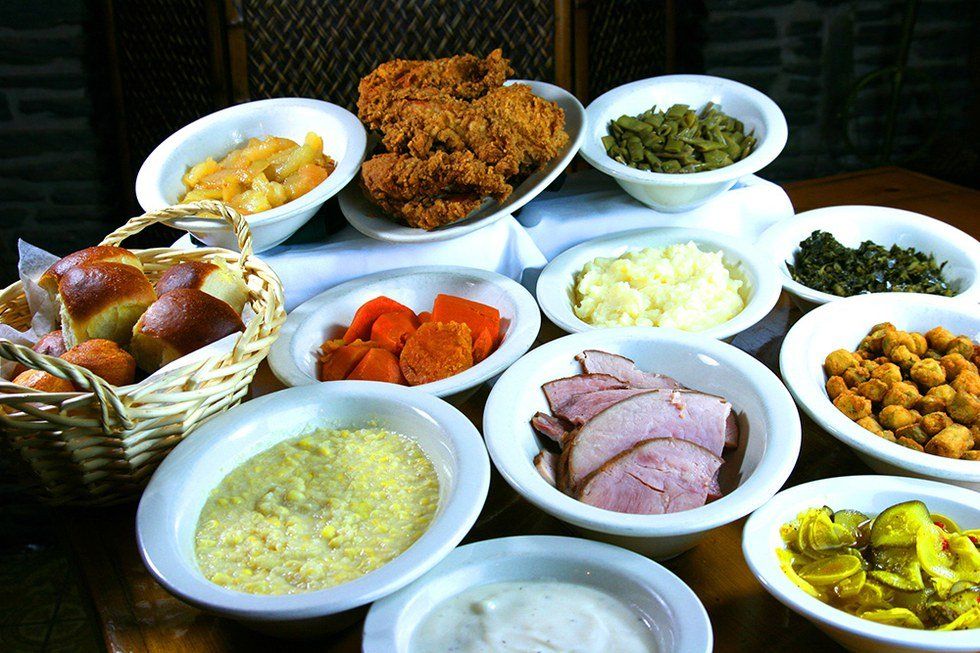After an hour and a half drive from our home in Johns Creek, Georgia, we finally arrived at our destination. Nestled among the colorful clusters of assorted shops that make up the heart of downtown Dahlonega, in all its familiarity and geniality, was The Smith House.
The minute we opened its doors, we were overwhelmed by a mouthwatering aroma that had gently wafted out to its parking grounds. We entered through its gift shop which was filled with typical items, like t-shirts, magnets and keychains, as well as more unusual ones, including handcrafted charms, color changing cups, mineral shaped soaps and miner’s helmets. Its interior was brightly lit and a kind warmth encased us, contrasting the cold outside. Basking in a homely snugness, we walked across the wooden floors to check in for dinner and made our way downstairs to the dining area.
Just beyond the staircase was a small room that displayed one of The Smith House’s most popular attractions: its original mine shaft. As the story goes, in 1884, Captain Frank Wayland Hall purchased a tract of land east of town square, where The Smith House is located today. As he began to build a home, he discovered a gold and quartz vein that ran through his property. Although he sought mining rights, he was denied by the city and died before he could see his plans to fruition. The Hall property was then purchased by Henry and Bessie Smith, for whom The Smith House was named after. They converted the property to an inn and offered home cooked meals in addition to lodging, demonstrating the very definition of southern hospitality. Bessie Smith’s cooking soon attracted more than just travelers. Word spread of her delicious cooking and drew guests to its doors simply to taste her “famous buttermilk fried chicken, country ham and garden fresh vegetables.” The Smith House was then purchased by Fred and Thelma Welch, who continued The Smith House’s longstanding operations and even added to its standard dishes to create its current menu. The mine shaft was only discovered, to their astonishment, when their son, Freddy, and his wife, Shirley, remodeled the lower floor where the dining room was to be relocated. The mine shaft is still conserved today for visitors to view, a lasting reminder of the spirit of the gold rush and the unique history The Smith House boasts.
But the mineshaft only adds to the quaint charm of The Smith House and their main attraction: food. As we approached the dining hall, we were greeted by a familiar, though incredible, sight of a multitude of families and friends enjoying their Saturday night dinners. The hall was filled to the brim with both lodgers and diners and their animated conversations bounced off its baby blue walls, emanating a lively spirit. Antique designs and wooden pieces decorated the walls, complementing the long wooden tables that have been used since The Smith House first opened.
When we were finally seated, a basket of soft, buttery dinner rolls and golden corn muffins awaited us, foreshadowing the many more delights to come. Just a few minutes later, our table was filled with their famous buffet-style dishes: creamed corn, crispy fried okra, steaming collard greens, mac and cheese, green beans, sliced country ham, richly seasoned pot roast, mashed potatoes and gravy and, of course, buttermilk fried chicken. And as if that were not enough, we ended with a fresh strawberry cobbler topped with a mountain of whipped cream.
We easily sat there for hours, talking, laughing and savoring southern comfort foods at its finest with the merry choruses of other families echoing around us. Coupled with family, friends, and hearty conversation, immersed in a nostalgic, old time history-drenched atmosphere, an evening at The Smith House is truly one of a kind.





















